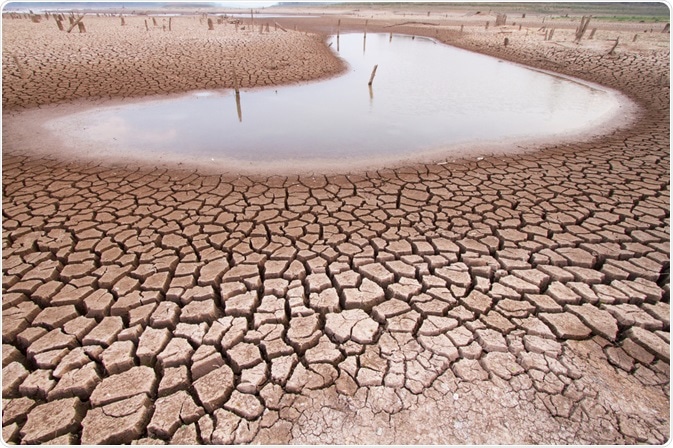With the rise of global temperatures, droughts are an inevitable consequence that has and will continue to, affect the agricultural sector.

Image Credit: Piyaset/Shutterstock.com
Introduction
Global warming and increasing climate variability have caused a greater number of droughts to arise in many rivers around the world, particularly those that exist at intermediate and high latitudes. As temperatures continue to rise, researchers predict that more frequent, severe droughts will occur for longer durations.
The agricultural sector throughout the world strongly depends upon water resources to support crop yields and productivity; therefore, droughts pose a major threat to this industry.
Types of droughts
Droughts can be broadly classified into four different types, which include meteorological, agricultural, hydrological, and socioeconomic droughts. Meteorological drought is defined as a significant reduction and/or absence of precipitation, whereas an agricultural drought is defined as a complete reduction in soil moisture. Hydrological droughts occur when there is a deficit in runoff, groundwater, and/or total water storage.
Lastly, a socioeconomic drought takes the public supply and demand for water into consideration, while also measuring the social response to this event. Regardless of what type of drought is being discussed, all droughts can be associated with a sustained reduction in precipitation.
What happens during agricultural droughts?
An agricultural drought represents the combined impact of both meteorological and hydrological droughts. Taken together, an agricultural drought will arise due to reduced precipitation levels, significant differences that arise between actual and potential evapotranspiration, as well as deficits in soil water, groundwater, and/or reservoir levels.
The growth cycle of all crops requires specific temperatures, moisture levels, and nutrient conditions to retain optimal growth. When moisture levels are depleted, this growth cycle is compromised, thereby leading to a reduction in crop yield that has many downstream effects.
Economic loss
In the United States, droughts are the most expensive natural hazard after tropical storms, averaging at an economic cost of approximately $9.4 billion, with damage costs that can reach up to $43 billion.
The agricultural sector is considered to be one of the most vulnerable industries to the effects of drought, as this extreme weather condition can, directly and indirectly, alter the production of crops.
Throughout history, the economic cost of certain droughts has been analyzed. For example, between 1988 and 1989, droughts in the United States led to crop losses that were valued at $15 billion.
Comparatively, between 2001 and 2002, a Canadian drought led to crop losses estimated to cost $2.3 billion. Between 2014 and 2016 in the state of California alone, droughts caused significant crop losses valued at $2 billion, alone with dairy and livestock losses of $533 million and groundwater pumping costs of $1.3 billion.
Agricultural land conversion
Agricultural land conversion (ALC) is the conversion of land that was previously used for agricultural purposes to urban land. One of the most significant drivers of ALC is population growth to accommodate the continuously rising world population.
However, as more agricultural land is repurposed into urban areas, the world food production inevitably gets affected. Aside from growing population concerns, several bio-physical factors also increase ALC, which include topography, soil types, fertility, water scarcity, and climate change.
An increased frequency and intensity of environmental hazards like droughts is one of the most significant impacts on ALC. As more previously cultivated lands are converted into urban areas to meet the demands of economic development in countries around the world, many of the factors that contribute to the occurrence of drought also intensify.
More specifically, ALC reduces groundwater volumes, levels of water reserves within aquifers and increases the intensity and frequency of floods, all of which can create an even more vulnerable situation to develop on farmlands.
Socioeconomic effects
An increase in the frequency, intensity, and duration of droughts will inevitably contribute to innumerable health issues, which will inevitably alter the quality of life in affected individuals, loss of income, reduced access to alternative income sources, increased workload demands, and a lack of educational access.
In 2011, the World Health Organization (WHO) found that the water and food shortages that result from droughts are likely to cause long-term environmental and health risks for people. Therefore, many individuals looking to escape drought-stricken areas to locations with better water and food supplies can increase the stress put on highly crowded urban areas.
Many of these socioeconomic issues will inevitably dawn on farmers, causing these individuals to leave farming and shrink global agricultural operations. In fact, during drought years, the annual revenue of farming households can drop by up to 50%, which puts an even greater financial burden on farm families.
One example of how continuous droughts can lead to severe socioeconomic impacts can be found in the state of Karnataka in India, where droughts have reduced crop yields and subsequently lead to an increase in poverty in this region.
References and Further Reading
- Garcia-Leon, D., Standardi, G., & Staccione, A. (2021). An integrated approach for the estimation of agricultural drought costs. Land Use Policy 100. doi:10.1016/j.landusepol.2020.104923.
- Musolino, D. A., Massarutto, A., & de Carli, A. (2018). Does drought always cause economic losses in agriculture? An empirical investigation on the distributive effects of drought events in some areas of Southern Europe. Science of the Total Environment 633; 1560-1570. doi:10.1016/j.scitotenv.2018.01.308.
- Lu, H., Wu, Y., Li, Y., & Liu, Y. (2017). Effects of meteorological drought on agricultural water resources in southern China. Journal of Hydrology 548; 419-435. doi:10.1016/j.jhydrol.2017.03.021.
- Kuwayama, Y. (2019). The Economic Impacts of Drought on US Agriculture. Resources Mag. Accessed on 11 September 2020. https://www.resourcesmag.org/archives/economic-impacts-drought-us-agriculture/.
- Azadi, H., Keramati, P., Taheri, F., et al. (2018). Agricultural land conversion: Reviewing drought impacts and coping strategies. International Journal of Disaster Risk Reduction 31; 184-195. doi:10.1016/j.ijdrr.2018.05.003.
Further Reading